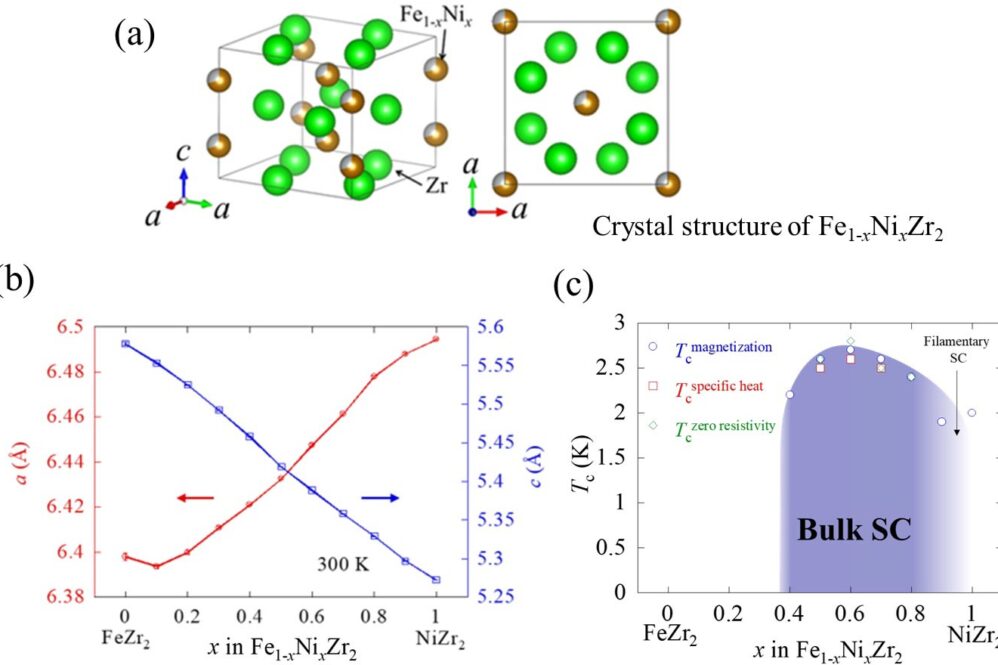A significant advancement in superconductor research has emerged from Tokyo Metropolitan University, where researchers discovered superconductivity in a novel polycrystalline alloy combining iron, nickel, and zirconium. Led by Associate Professor Yoshikazu Mizuguchi, the team developed this groundbreaking material through arc melting, creating various ratios of the three elements.
The discovery is particularly noteworthy because neither pure iron zirconide nor nickel zirconide exhibits superconducting properties individually. However, when combined in specific proportions, the resulting alloy demonstrates clear superconducting characteristics. The material maintains the same crystal structure as tetragonal transition-metal zirconides, with lattice constants varying smoothly based on the iron-to-nickel ratio.
A key finding is the emergence of a “dome-shaped” phase diagram in the material’s behavior, where the superconducting transition temperature rises and falls across different compositional ratios. This pattern is a characteristic signature of unconventional superconductivity, distinguishing it from traditional superconductors that follow the BCS (Bardeen-Cooper-Schrieffer) theory.
The research gains additional significance from the observed magnetic properties, particularly in nickel zirconide, which shows magnetic-transition-like anomalies. This observation aligns with current understanding of unconventional superconductivity, where magnetic ordering appears to play a crucial role in the phenomenon.
This breakthrough builds upon the 2008 discovery of iron-based superconductors, furthering our understanding of high-temperature superconductivity mechanisms. The field has increasingly focused on materials containing magnetic elements, as they seem to facilitate unconventional superconductivity through mechanisms distinct from traditional superconductors.
The practical implications of this research are substantial. Current superconducting technologies, while already crucial in applications like medical imaging, maglev trains, and power transmission, require extreme cooling to around 4 Kelvin. This necessity for such low temperatures significantly limits their practical implementation and increases operational costs. Researchers aim to develop materials that achieve superconductivity at higher temperatures, particularly above 77 Kelvin, where more cost-effective liquid nitrogen could replace liquid helium as a coolant.
What makes this discovery particularly remarkable is its origin as an undergraduate student project, demonstrating the potential for breakthrough innovations at various academic levels. The systematic approach to combining these elements and analyzing their properties has opened new avenues for understanding unconventional superconductivity.
The research team anticipates that this new material platform will advance both theoretical understanding and practical applications. It provides a fresh perspective for studying unconventional superconductivity mechanisms and could inform the design of next-generation superconducting devices. The systematic variation in properties with composition ratios offers valuable insights into the relationship between material structure and superconducting behavior.
This discovery represents not just a new material but a potential pathway toward more practical and efficient superconducting technologies. By combining magnetic elements in novel ways, the research suggests promising directions for developing high-temperature superconductors that could revolutionize energy transmission and electronic devices.
The finding contributes to the broader scientific understanding of unconventional superconductivity and highlights the importance of exploring complex alloy systems. It demonstrates that even well-studied elements can yield surprising properties when combined in specific ways, encouraging further investigation into similar material combinations.
Reference: “Superconducting properties and electronic structure of CuAl2-type transition-metal zirconide Fe1-xNixZr2” by Ryunosuke Shimada, Yuto Watanabe, Lorenzo Tortora, Giovanni Tomassucci, Muammer Yasin Hacisalihoglu, Hiroto Arima, Aichi Yamashita, Akira Miura, Chikako Moriyoshi, Naurang L. Saini and Yoshikazu Mizuguchi, 7 November 2024, Journal of Alloys and Compounds. DOI: 10.1016/j.jallcom.2024.177442




